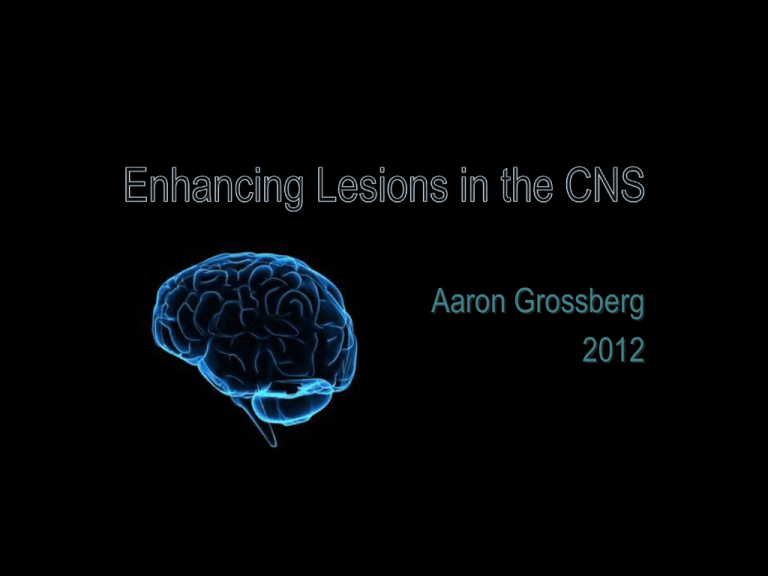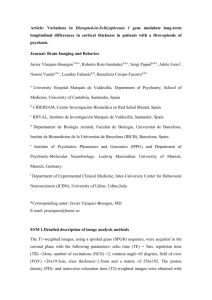Aaron Grossberg 2012
advertisement

Aaron Grossberg 2012 • Increased blood flow – Intravascular – Rapidly appears after contrast administration • Capillary leak – Extravascular/interstitial – BBB normally impermeable to contrast – Slow appearing • Often 10-15 min after administration • Increased blood flow – Neovascularity • Tumor • Granulation tissue capsule – Inflammation – Reperfusion (post-ischemia) • Capillary leak – – – – – – Inflammation Trauma Post surgical changes Granulomatous disease Ischemia Multiple sclerosis 1. Herpes simplex encephalitis - extravascular/capillary leak = inflammation Follows olfactory pathways from nasal cavity to brain - Medial temporal lobe Uncus Cingulate gyrus Gadolinium – enhanced T1 Smirniotopolous et al. Radiographics. 2009 2. Cerebral infarction (acute) - extravascular/capillary leak = endothelial damage Increased blood flow - - Hyperemia 2º to elevated CO2 after tissue injury Wedge-shaped Smirniotopolous et al. Radiographics. 2009 3. Cerebral infarction (several weeks later) - Vascular hypertrophy = Increased blood flow - - Fades by 4 weeks – 4 months after event Necessary to repair/remove necrotic tissue Only in reperfused tissue 4+ weeks Smirniotopolous et al. Radiographics. 2009 Metastatic malignancies Well-circumscribed < 2 cm in diameter Grey matter-white matter junction – most common – – – • Primary tumors usually deeper Usually cause symptoms, even when small – • Due to location of lesions CT scan metastatic melanoma Gadolinium-enhanced T1-weighted MR metastatic breast cancer Smirniotopolous et al. Radiographics. 2009 Enhancing Ring hyperemia - inflammation neovascularity - tumor capillary leak - inflammation ** can be due to any ring-enhancing process Center hypoattenuating - necrosis (tumor/abscess) - pus (abscess) - fluid (low grade tumor/cyst) isoattenuating - normal tissue (demyelinating disease) Gadolinium-enhanced T1-weighted MR metastatic breast cancer - subcortical/cortical - well-circumscribed - small ( < 2 cm) Smirniotopolous et al. Radiographics. 2009 Enhancing Ring (T1-weighted MRI) neovascular thick - wall > 10 mm irregular Necrotic Center (T1-weighted MRI) Crown of vasogenic edema (T2-weighted MRI) Mass effect Smirniotopolous et al. Radiographics. 2009 Gadolinium-enhanced T2-weighted MR Gadolinium-enhanced T1-weighted MR Enhancing Ring (T1-weighted MRI) thinner than high grade may appear incomplete - part of ring is neoplastic, part is gliotic (nonenhancing) mural nodule DDx: Pilocytic astrocytoma (cerebellum) Hemangioblastoma (cerebellum) Ganglioglioma Pleomorphic xanthoastrocytoma “Cystic” fluid-filled Center (T1-weighted MRI) - not true cyst -“cyst” w/ nodule appearance Mural nodule Smirniotopolous et al. Radiographics. 2009 Non-enhanced T1-weighted MR Gadolinium-enhanced T1-weighted MR Enhancing Ring (contrast T1-weighted MRI) thin-walled (< 10 mm) – better evaluated on T2-weighted image Non-enhancing Center (contrast T1) - In abscess, center will be hypoattenuated due to pus accumulation - In cerebritis, center may fill in with contrast over 20-40 minutes Perilesional vasogenic edema (contrast T2) Restricted diffusion (diffusion-weighted) - hyperintense Gadolinium-enhanced T2-weighted MR Gadolinium-enhanced T1-weighted MR contrast CT diffusion-weighted MR Smirniotopolous et al. Radiographics. 2009 Gadolinium-enhanced T2-weighted MR T1-weighted MR Enhancing Ring (contrast T1-weighted) faint ring enhancement perivascular, not intravascular often appears “incomplete” Isoattenuated Center (T1-weighted) - no necrosis No perilesional vasogenic edema (T2 –weighted) Smirniotopolous et al. Radiographics. 2009 **If MS is suspected, MRI of spinal cord may show add’l lesions Enhancing rim complete v. incomplete? complete incomplete Center attenuation hypo v. iso? Thick & irregular rim or thin & smooth rim? thin & smooth thick & irregular single deep lesion or multiple superficial? multiple superficial metastatic malignancy single deep high grade glioma (GBM) iso mural nodule? no hypo yes Demyelination (multiple sclerosis) abscess/cerebritis cystic neoplasm (low grade glioma) Glioblastoma multiforme thick-walled irregular internal ring necrotic, heterogeneous center abscess thin-walled smooth internal ring homogeneous, hypoattenuating center Multiple sclerosis incomplete ring isoattenuating center No vasogenic edema pilocytic astrocytoma complete v. incomplete ring hypoattenuating, fluid-filled center mural nodule THICK PERIVENTRICULAR ENHANCEMENT * Neoplastic primary CNS lymphoma - homogenous “lamb’s wool” on contrast-enhanced imaging high grade glial tumor ¤ metastatic lymphoma often involves cortex or meninges THIN PERIVENTRICULAR ENHANCEMENT thin enhancement (< 2 mm) along ventricle margin * Infectious ependymitis/ventriculitis - often CMV in immunocompromised patients Smirniotopolous et al. Radiographics. 2009 MRI Non-enhanced CT enhanced Gadolinium-enhanced, T1-weighted THICK PERIVENTRICULAR ENHANCEMENT THIN PERIVENTRICULAR ENHANCEMENT Primary CNS lymphoma in adult patient with AIDS CMV ependymitis Smirniotopolous et al. Radiographics. 2009 1. 2. 3. Dural vs. Pial - Dura (pachymeningeal) – along surface of skull - Pia (leptomeningeal) – follows sulci & subarachnoid spaces Linear vs. curvilinear Associated with mass/nodule? Remember: Thin Dural enhancement normal on CT Very vascular No BBB in dura mater Dural Pial Dura hypo-intense on T1 Thin linear enhancement with contrast Smirniotopolous et al. Radiographics. 2009 Gadolinium-enhanced T1 Intracranial hypotension - increased fluid shifts - increased venous capacitance Gadolinium-enhanced T1 Meningioma - enhancing hypervascular tumor - enhancing dural “tail” - vasocongestion - interstitial edema Smirniotopolous et al. Radiographics. 2009 Gadolinium-enhanced T1 Bacterial meningitis - thin, linear enhancement - capillary leak - cytokines & bacterial glycoproteins - Fungal meningits may produce thick, lumpy, or nodular enhancement Gadolinium-enhanced T1 Contrast-enhanced CT Carcinomatous meningitis - Spread of tumor through subarachnoid space - May still appear thin and linear - capillary leak - cytokines & tumor products Smirniotopolous et al. Radiographics. 2009 FLAIR Gadolinium-enhanced T1 Also seen in CNS granulomatous disease: Sarcoid TB/fungus Wegener granulomatosis Luetic gummas Rheumatoid nodules **All typically involve basilar meninges, Sparing the convexities Metastatic dural disease - Enhancement of sulci (pial) and inner margin of skull (dural) - Most commonly secondary to breast or prostate cancer; can be lymphoma, as well - lack of BBB predisposes to metastatic seeding Smirniotopolous et al. Radiographics. 2009


